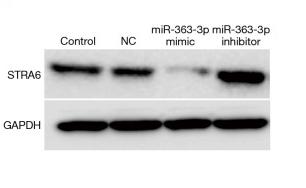STRA6 Antibody - #DF12756
| Product: | STRA6 Antibody |
| Catalog: | DF12756 |
| Description: | Rabbit polyclonal antibody to STRA6 |
| Application: | WB |
| Reactivity: | Human, Mouse, Rat |
| Prediction: | Pig, Bovine, Horse, Sheep |
| Mol.Wt.: | 95 kDa, 70 kDa; 74kD(Calculated). |
| Uniprot: | Q9BX79 |
| RRID: | AB_2845717 |
Related Downloads
Protocols
Product Info
*The optimal dilutions should be determined by the end user.
*Tips:
WB: For western blot detection of denatured protein samples. IHC: For immunohistochemical detection of paraffin sections (IHC-p) or frozen sections (IHC-f) of tissue samples. IF/ICC: For immunofluorescence detection of cell samples. ELISA(peptide): For ELISA detection of antigenic peptide.
Cite Format: Affinity Biosciences Cat# DF12756, RRID:AB_2845717.
Fold/Unfold
MCOPCB8; MCOPS9; PP14296; Stimulated by retinoic acid 6 homolog; Stimulated by retinoic acid gene 6 protein homolog; STRA6; STRA6_HUMAN;
Immunogens
Broad expression. In adult eye expressed in sclera, retina, retinal pigment epithelium, and trabecular meshwork but not in choroid and iris.
- Q9BX79 STRA6_HUMAN:
- Protein BLAST With
- NCBI/
- ExPASy/
- Uniprot
MSSQPAGNQTSPGATEDYSYGSWYIDEPQGGEELQPEGEVPSCHTSIPPGLYHACLASLSILVLLLLAMLVRRRQLWPDCVRGRPGLPSPVDFLAGDRPRAVPAAVFMVLLSSLCLLLPDEDALPFLTLASAPSQDGKTEAPRGAWKILGLFYYAALYYPLAACATAGHTAAHLLGSTLSWAHLGVQVWQRAECPQVPKIYKYYSLLASLPLLLGLGFLSLWYPVQLVRSFSRRTGAGSKGLQSSYSEEYLRNLLCRKKLGSSYHTSKHGFLSWARVCLRHCIYTPQPGFHLPLKLVLSATLTGTAIYQVALLLLVGVVPTIQKVRAGVTTDVSYLLAGFGIVLSEDKQEVVELVKHHLWALEVCYISALVLSCLLTFLVLMRSLVTHRTNLRALHRGAALDLSPLHRSPHPSRQAIFCWMSFSAYQTAFICLGLLVQQIIFFLGTTALAFLVLMPVLHGRNLLLFRSLESSWPFWLTLALAVILQNMAAHWVFLETHDGHPQLTNRRVLYAATFLLFPLNVLVGAMVATWRVLLSALYNAIHLGQMDLSLLPPRAATLDPGYYTYRNFLKIEVSQSHPAMTAFCSLLLQAQSLLPRTMAAPQDSLRPGEEDEGMQLLQTKDSMAKGARPGASRGRARWGLAYTLLHNPTLQVFRKTALLGANGAQP
Predictions
Score>80(red) has high confidence and is suggested to be used for WB detection. *The prediction model is mainly based on the alignment of immunogen sequences, the results are for reference only, not as the basis of quality assurance.
High(score>80) Medium(80>score>50) Low(score<50) No confidence
PTMs - Q9BX79 As Substrate
| Site | PTM Type | Enzyme | Source |
|---|---|---|---|
| S89 | Phosphorylation | Uniprot | |
| S247 | Phosphorylation | Uniprot | |
| Y250 | Phosphorylation | Uniprot | |
| S263 | Phosphorylation | Uniprot | |
| Y264 | Phosphorylation | Uniprot | |
| S404 | Phosphorylation | Uniprot | |
| S409 | Phosphorylation | Uniprot | |
| Y564 | Phosphorylation | Uniprot | |
| T565 | Phosphorylation | Uniprot | |
| S575 | Phosphorylation | Uniprot | |
| T582 | Phosphorylation | Uniprot | |
| S605 | Phosphorylation | Uniprot | |
| K621 | Ubiquitination | Uniprot | |
| Y643 | Phosphorylation | Uniprot |
Research Backgrounds
Functions as retinol transporter. Accepts all-trans retinol from the extracellular retinol-binding protein RBP4, facilitates retinol transport across the cell membrane, and then transfers retinol to the cytoplasmic retinol-binding protein RBP1. Retinol uptake is enhanced by LRAT, an enzyme that converts retinol to all-trans retinyl esters, the storage forms of vitamin A. Contributes to the activation of a signaling cascade that depends on retinol transport and LRAT-dependent generation of retinol metabolites that then trigger activation of JAK2 and its target STAT5, and ultimately increase the expression of SOCS3 and inhibit cellular responses to insulin. Important for the homeostasis of vitamin A and its derivatives, such as retinoic acid. STRA6-mediated transport is particularly important in the eye, and under conditions of dietary vitamin A deficiency (Probable). Does not transport retinoic acid.
Phosphorylated on tyrosine residues in response to RBP4 binding. Phosphorylation requires the presence of LRAT, suggesting it may be triggered by the uptake of retinol that is then metabolized within the cell to retinoids that function as signaling molecules.
Cell membrane>Multi-pass membrane protein.
Note: In the retinal pigment epithelium localizes to the basolateral membrane.
Broad expression. In adult eye expressed in sclera, retina, retinal pigment epithelium, and trabecular meshwork but not in choroid and iris.
Homodimer (By similarity). Interacts with JAK2 and STAT5. Interacts (via extracellular domains) with RBP4. Interacts (via cytoplasmic domains) with RBP1.
Contrary to predictions, contains nine transmembrane helices, with an extracellular N-terminus and a cytoplasmic C-terminus (By similarity). Besides, contains one long helix that dips into the membrane and then runs more or less parallel to the membrane surface (By similarity).
References
Application: WB Species: Rat Sample: lung cell
Application: WB Species: Rat Sample: lung alveolar type II cells
Restrictive clause
Affinity Biosciences tests all products strictly. Citations are provided as a resource for additional applications that have not been validated by Affinity Biosciences. Please choose the appropriate format for each application and consult Materials and Methods sections for additional details about the use of any product in these publications.
For Research Use Only.
Not for use in diagnostic or therapeutic procedures. Not for resale. Not for distribution without written consent. Affinity Biosciences will not be held responsible for patent infringement or other violations that may occur with the use of our products. Affinity Biosciences, Affinity Biosciences Logo and all other trademarks are the property of Affinity Biosciences LTD.


